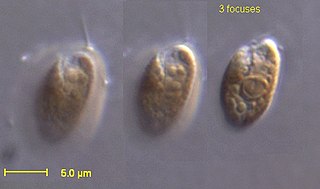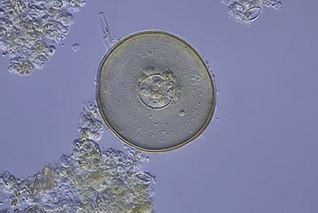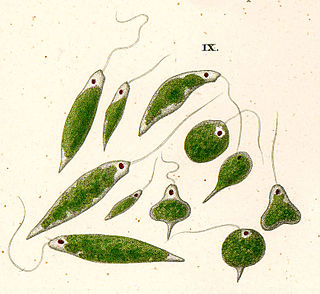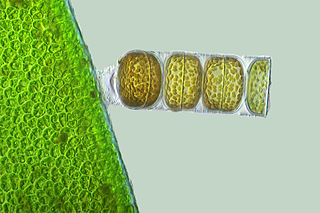Cryptomonas is the name-giving genus of the Cryptomonads established by German biologist Christian Gottfried Ehrenberg in 1831. The algae are common in freshwater habitats and brackish water worldwide and often form blooms in greater depths of lakes. The cells are usually brownish or greenish in color and are characteristic of having a slit-like furrow at the anterior. They are not known to produce any toxins. They are used to feed small zooplankton, which is the food source for small fish in fish farms. Many species of Cryptomonas can only be identified by DNA sequencing. Cryptomonas can be found in several marine ecosystems in Australia and South Korea.

The cryptophyceae are a class of algae, most of which have plastids. About 220 species are known, and they are common in freshwater, and also occur in marine and brackish habitats. Each cell is around 10–50 μm in size and flattened in shape, with an anterior groove or pocket. At the edge of the pocket there are typically two slightly unequal flagella.

Bodo is a genus of microscopic kinetoplastids, flagellate excavates first described in 1831 by Christian Gottfried Ehrenberg. The genus is small, as it has recently been redefined to include only four species. Bodo includes free-living, phagotrophic organisms that can be found in many marine and freshwater environments as well as some terrestrial environments. Being phagotrophic, Bodo feeds on bacteria and other microorganisms that it finds while swimming through its water-based habitats. The swimming-like movement is facilitated by the two unequal flagella that Bodo possesses which arise from an anteriorly located flagellar pocket. Bodo is roughly bean-shaped and is often missed in samples from water or terrestrial environments due to its small size.
Craticula is a genus of diatom that lies on or in the top layers of sediments in the freshwater to brackish water environments it inhabits. In addition to frustule morphology the genus differs from closely related species by its sexual reproduction and movement in response to light.

Peridinium is a genus of motile, marine and freshwater dinoflagellates. Their morphology is considered typical of the armoured dinoflagellates, and their form is commonly used in diagrams of a dinoflagellate's structure. Peridinium can range from 30 to 70 μm in diameter, and has very thick thecal plates.

Arcella is a genus of testate amoebae in the order Arcellinida, usually found in freshwaters and mosses, and rarely in soils. A key characteristic of Arcella is the circular test with a hole on its center from where finger-like pseudopods emerge. It is one of the largest testacean genera.

Euglena viridis is a freshwater, single cell, mixotroph microalgae bearing a secondary chloroplast. Their chloroplast is bounded by three layers of membrane without a nucleomorph. Normally, it is 40–65 μm long, slightly bigger than other well-known Euglena species: Euglena gracilis.
Climacosphenia is a genus of marine pennate diatoms in the order Fragilariophyceae.

Eunotia is a genus of diatoms. They are fresh water diatoms, specifically common in lakes, and they are also common in fossil records, although their siliceous wall design may have been lost and they appear plane, an example is Eunotia tetradon.
Navicula cari is a species of algae in the genus Navicula. Navicula cari occur in eutrophic waters.

Actinoptychus is a genus of diatoms belonging to the family Heliopeltaceae.
Amphiprora is a genus of diatoms belonging to the family Amphipleuraceae.
Glenodinium is a genus of dinoflagellates with unknown classification.
Grammatophora is a genus of Chromista belonging to the family Grammatophoraceae.
Ulnaria ulna is a species of diatom belonging to the family Ulnariaceae.
Hantzschia amphioxys is a species of diatom belonging to the family Bacillariaceae.
Actiniscus pentasterias is a species of dinoflagellate belonging to the family Actiniscaceae.
Anomoeoneis is a genus of diatoms belonging to the family Anomoeoneidaceae.

Melosira is a genus of diatoms belonging to the family Melosiraceae.

Nemertes is a genus of worms, family and order unidentified.







